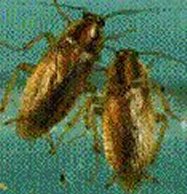
GERMAN COCKROACHES
The German cockroach is the most common cockroach species in buildings throughout the United States. Although other species in certain parts of the country may pose as much, if not more, or a problem, the German cockroach, also referred to sometimes as the Croton Bug, is the most common nationwide. |
HABITS
The German cockroach is most active at night, and hide in dark crevices during the day. If any are seen during the day, it usually indicates a large infestation. Their harborage areas are dark cracks and crevices near food and water, which usually indicates in kitchens and other food areas. They prefer wood surfaces rather than metal, glass, or other smooth surfaces.
The German cockroach is a general feeder but prefers fermented foods and beverage spills. If water is present, adults can live approximately one month or longer without food. Deprived of food or water, or enough food and water for the size of the population, cockroach populations tend to forage further from conventional areas and may forage during the day. However, the location of German cockroaches in non-food areas may also be the result of the use of repellent insecticides. Also, movement of German cockroaches from one apartment to another is most likely to occur when the apartments share common plumbing. Therefore, sealing around the plumbing should help to prevent shared infestations. Also, treatment with appropriate insecticides or baits near the pipes, or walls that may contain these pipes, should be done, even if precautionary. |
| The first key to prevention of German cockroach infestation is SANITATION. This will reduce or eliminate food, moisture and harborage available to the cockroaches. Sanitation includes the immediate cleaning of spilled foods with cleaning products, the regular disposal of refuse, the removal of harborage areas by caulking or other methods, and the repair and upkeep of plumbing to reduce the availability of moisture. |
| The next area of concern has to do with EXCLUSION. With German cockroaches, this usually means inspecting all packages, furniture, and other such items that could carry in German cockroaches or their oothecae. Be sure to check corrugated cardboard boxes as well, for German cockroaches can not only hide in the corrugation, they may also feed on the glue used to make the box. Finally, storage of food products or items near food products should not be done within such items. |
| Finally, the use of PESTICIDES for the treatment of cockroaches may be needed. The first step in determining if and how much pesticide treatment is needed is to determine the level of infestation. An inspection, using a flashlight, should be performed. Be sure to inspect all cracks and crevices such as under table tops, behind and under sinks, behind under and inside drawers, in cabinets, the motor compartments of refrigerators and soft drink dispensers, underneath the bases of kitchen equipment, in switchboxes and fuse boxes, and anywhere else you can think of. For small infestations and for prevention, the liberal use of cockroach bait, placed the above types of areas, along with sanitation procedures, should solve or prevent any German cockroach problems. For mild infestations, aerosol treatments in cracks and crevices, along with immediate cleaning and the use of baits, should suffice. However, heavy infestations, and to some degree mild infestations, should be handled by a pest management professional. |

